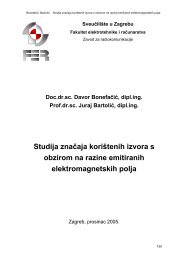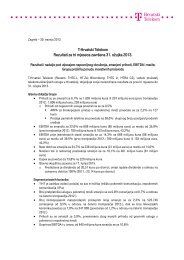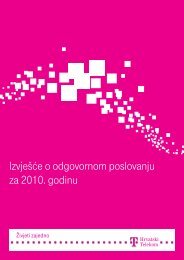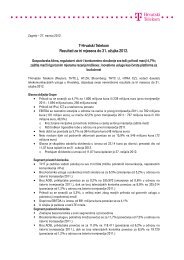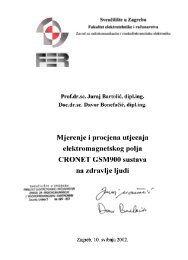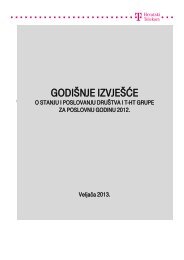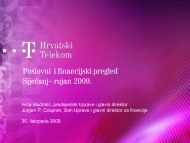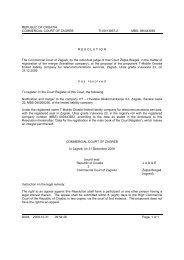Annual report 2007 - T-Hrvatski Telekom
Annual report 2007 - T-Hrvatski Telekom
Annual report 2007 - T-Hrvatski Telekom
Create successful ePaper yourself
Turn your PDF publications into a flip-book with our unique Google optimized e-Paper software.
Business Review <strong>2007</strong><br />
a competitive price level and<br />
increase customer satisfaction,<br />
in <strong>2007</strong> T-Com aligned the prices<br />
of the Metro Ethernet and IP VPN<br />
services with the market (whilst<br />
retaining the T-Com brand and<br />
service price premium). In order<br />
to increase customer satisfaction,<br />
T-Com promoted migrations<br />
towards higher speeds.<br />
Retail Sales Channels<br />
T-Com’s retail sales organization<br />
comprises three centrally<br />
headquartered sales departments:<br />
sales department for key/large<br />
business accounts, sales<br />
department for small and medium<br />
business accounts, and sales<br />
department for residential<br />
customers. Each sales<br />
department is responsible for<br />
sales analysis, planning, defining<br />
sales procedures and sales<br />
strategy development within their<br />
respective customer base.<br />
There are also four regional sales<br />
units with their headquarters<br />
in Zagreb, Split, Rijeka and<br />
Osijek. They perform the full<br />
scope of front-office and backoffice<br />
sales operations: service<br />
contracting, order fulfilment and<br />
after sales support. In order to<br />
achieve proper coverage of each<br />
customer segment throughout<br />
Croatia, T-Com (including Iskon)<br />
uses a multi-channel approach<br />
which comprises the following<br />
sales channels: T-Com business<br />
sales representatives, T-Centres,<br />
telesales, web sales and indirect<br />
partners such as shops and<br />
business sales representatives.<br />
Telesales and web sales activities<br />
are managed by a Customer<br />
Services subunit.<br />
For sales to residential and home<br />
office customers, there are 54<br />
T-Centres located in all Croatia’s<br />
cities and major towns<br />
(41 of them) which sell both<br />
T-Com and T-Mobile services.<br />
T-Com (including Iskon) also has<br />
a network of 86 indirect partners<br />
(using the ‘shop in shop’ concept)<br />
as well as telesales and websales.<br />
The Group has an efficient sales<br />
channel structure which includes<br />
the sharing of resources between<br />
T-Com and T-Mobile. In order<br />
to harmonise the sales approach<br />
and synchronize the sales support<br />
process, a joint T-Com / T-Mobile<br />
approach was developed in <strong>2007</strong>.<br />
This joint approach has a number<br />
of benefits, including:<br />
providing one face<br />
to the customer;<br />
offering a uniformly high level<br />
of service to all customers;<br />
cost optimisation; and<br />
making the most of synergies<br />
through resource optimisation.<br />
In the project “One Face to<br />
the Customer”, Joint Residential<br />
sales was introduced<br />
on 1 November <strong>2007</strong>.<br />
•<br />
•<br />
•<br />
•<br />
Wholesale<br />
T-HT provides wholesale services<br />
to four major customer segments:<br />
international operators, mobile<br />
operators, fixed operators<br />
and a variety of different service<br />
providers (such as VAS providers,<br />
ISPs and VoIP service providers).<br />
Wholesale revenue increased<br />
by 10.9% to HRK 1,167 million<br />
in <strong>2007</strong> from HRK 1,052 million in<br />
2006, representing 21.4% of total<br />
T-Com’s revenue.<br />
The growth is primarily driven<br />
by continued market liberalisation,<br />
introduction of new services and<br />
increased hubbing traffic.<br />
The continued deregulation<br />
process in Croatia fostered further<br />
growth of interconnection revenue.<br />
Domestic Market<br />
In <strong>2007</strong>, there was further growth<br />
of the interconnection market<br />
based on the variety of services<br />
and the volume of their usage,<br />
although not at the same pace as<br />
in the previous year. The growth in<br />
the number of active CPS (carrier<br />
preselection) subscribers slowed<br />
down compared to previous years<br />
due to the shift of the operators’<br />
strategic focus to ULL. The<br />
increase in NP (number portability)<br />
is an outcome of considerable<br />
ULL activations.<br />
The main activities in <strong>2007</strong><br />
were related to the activation<br />
of Unbundled Local Loops and<br />
Collocation services for ULL<br />
purposes. T-Com signed six<br />
contracts for access to the local<br />
loop and delivered 245 locations<br />
(148 physical and 97 remote).<br />
38,179 lines were fully unbundled<br />
and handed over to operators,<br />
while a new service, SA (shared<br />
access), resulted in the delivery<br />
of 200 lines.<br />
IC traffic significantly increased<br />
as a direct outcome of an increased<br />
CPS and ULL customer base and<br />
increased average usage per<br />
customer. T-Com handed over<br />
approximately 50 locations<br />
throughout Croatia for local<br />
interconnections to meet<br />
operators’ requests,<br />
as interconnecting at the local<br />
level enables operators a better<br />
price spread and strengthens<br />
their competitiveness.<br />
44



